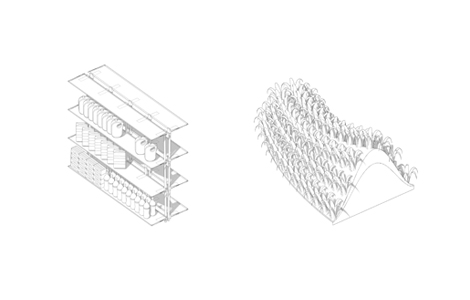LIMINAL ECOLOGIES : yielding suburban landscapes
This project investigates the marginal space in the city embodied in suburbia with the aim to ascertain how this space can be used to establish communication between the city and the landscapes that feed it and between people and the natural state and origin of their food. Urban – rural dichotomies in the 21st century have drastically changed the face of suburbia as an idealized housing model into transitional spaces that can be likened to biological ecotones. Just as the ecoton represents the place of conflict between two ecologies, the suburbia represents the place of conflict between two separate communities, which in the context of food can be divided into places of consumption (city) and production (rural landscapes). In the space where these communities overlap a distributive typology of the supermarket can be found, acting as a medium between the consumer and the producer. However, the supermarket causes further deepening of the rift between people and yielding natural landscapes with which feed them. Through the examination of the place that nature occupies in the city, on the easily recognizable typology of parks, an idea presents itself in the form of the suburban landscape which will treat nature not only as a means of communication as it is in city parks, but also as a rural yielding nature, which will reestablish a direct connection between the opposing sides of urban and rural or consumption and production.
Ovaj rad istražuje marginalno mesto u gradu koje se ispoljava kao predgrađe sa ciljem da utvrdi kako ovaj prostor može da se iskoristi za uspostavljanje komunikacije između grada i pejzaža koji ga prehranjuju, to jest između ljudi i prirodnog stanja i porekla njihove hrane. Urbano – ruralne dihotomije u 21. veku drastično menjaju lice predgrađa kao idealizovanog modela stanovanja u prelazne prostore koje je moguće poistovetiti sa biološkim ekotonima. Baš kao što ekoton prestavlja sukob dve ekologije tako i predgrađe predstavlja mesto sukoba dve zasebne zajednice koje u kontekstu ishrane delimo na konzumacione (grad) i proizvodne (ruralni predeli). Na secištu tih zajednica nastanjuje se distributivna tipologija supermarketa koja deluje kao medijum između potrošača i proizvođača. Ipak, supermarket prouzrokuje samo dalje produbljivanje nesporazuma i odvojenosti ljudi od prirodnih proizvodnih pejsaža koji ih hrane. Kroz ispitivanje toga koje mesto priroda zauzima u gradu na prepoznatljivoj tipologiji parka, javlja se ideja o uvođenju pojma suburbanog pejsaža koji će prirodu tretirati ne samo kao komunikativnu parkovsku prirodu, već i kao ruralnu proizvodnu prirodu i tako ponovo uspostaviti direktnu vezu između sukobljenih strana urbanog i ruralnog, konzumentskog i proizvodnog.
References
- Fogelson, Robert M. 2009. Bourgeois Nightmares Suburbia 1870 – 1930. Yale University Press.
- Lehrer, Ute. 2013. Flexspace – Suburban Forms, str.59. Suburban Constellations: Governance, Land and Infrastructure in the 21st Century. ed. Roger Keil, Jovis – Verlag GmBH.
- Lummel, Peter. 2012. Born-in-the-City: The Supermarket in Germany, in Peter Atkins, Derek J Oddy, Peter Lummel . Food and the City in Europe since 1800. p.172-p.173, Ashgate Publishing, Ltd.
- Croft, Robin. 2006. Folklore, Families and Fear: Exploring the Influence of the Oral Tradition on Consumer Decision-making. Journal of Marketing Management. p.1058, Routledge.
- Téchoueyres, Isabelle. 2012.Food Markets in the City of Bordeaux – From the 1960s until Today: Historical Evolution and Anthropological Aspects. Ashgate Publishing Ltd.
- Girot, Christophe. 2013. Immanent Landscape. Harvard Design Magazine issue 36 p. 12, President and Fellows of Harvard College
- Desvigne, Michel. 2009. Intermediate Natures: The Landscapes of Michel Desvigne. ed. Delphine Costedoat, Birkhauser Verlag AG
- Holzer, Sepp. 2012. Permakultur. Zvoneći Kedri Srbije, 2012.



